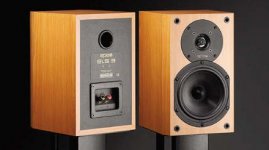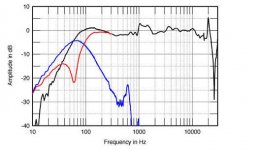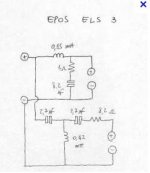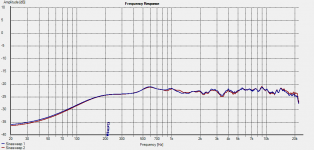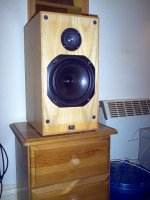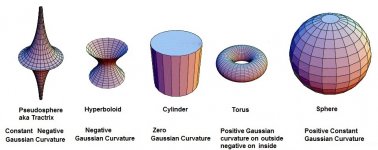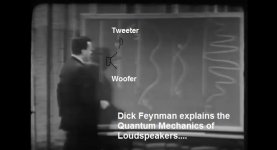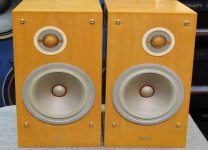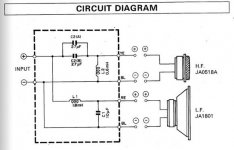It's possible to compare the two if you take into account the different time axes. My conclusion is that the second Morel is (marginally) better than the SEAS in that, if you look along the 1.7ms mark on both plots, there is less ringing in the Morel above about 8kHz. Not a lot in it apart from that, though.
The one Steve posted has two very clean modes at about 9kHz and 19kHz which persist to 3.5ms and 2.5ms respectively, which may well affect the subjective performance through intermodulation. That one looks worse than the latter two, so perhaps not a particularly representative sample of a soft-dome tweeter.
Alex
The one Steve posted has two very clean modes at about 9kHz and 19kHz which persist to 3.5ms and 2.5ms respectively, which may well affect the subjective performance through intermodulation. That one looks worse than the latter two, so perhaps not a particularly representative sample of a soft-dome tweeter.
Alex
The whole point is to show that soft dome tweeters do not have to suffer from sharp resonance ridges as shown by Steve - though he has a point.
Hard domes do this much better when properly designed. Problem is that there is quite few of those and they don't come cheap. I'd like to see hard dome under 100€ that doesn't have breakup below 30KHz.
Hard domes do this much better when properly designed. Problem is that there is quite few of those and they don't come cheap. I'd like to see hard dome under 100€ that doesn't have breakup below 30KHz.
I was going to post Vance Dickason's measurements of the latest ScanSpeak beryllium dome Revelator, but then noticed your price limit.
OK, can't resist - I'll do it anyway:
Test Bench: Scan-Speak D2908/714000 Revelator Beryllium 30-mm Dome Tweeter
Breakup quoted as 32.8kHz - Vance was impressed...
Alex
OK, can't resist - I'll do it anyway:
Test Bench: Scan-Speak D2908/714000 Revelator Beryllium 30-mm Dome Tweeter
Breakup quoted as 32.8kHz - Vance was impressed...
Alex
Last edited:
I'm not totally convinced expensive and wildly toxic beryllium rigid dome is actually necessary, Zvu. SB Acoustics :: SB29BAC-C000-4
If aluminium resonance is up around 27kHz, surely that is good enough?
I didn't make this Morel 1" soft-dome waterfall up. It's by the respected Vance Dickason at Voicecoil. aka audioXpress The Leading Global Audio Engineering & Development Magazine IIRC.
There are certain difficulties, because Vance uses different scales quite a lot with different tweeters.
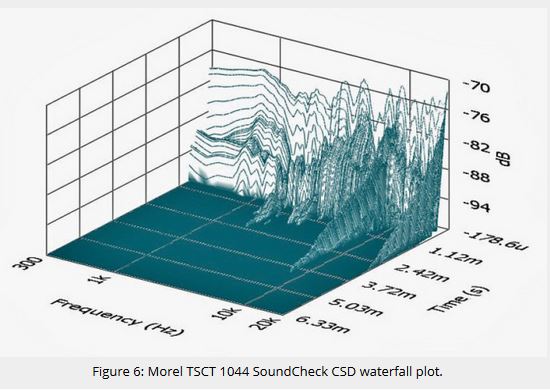
On the subject of ideal speaker materials, well, I really don't know. We mostly all have heard plastic polycone woofers. Paper cones and metal cones. They successively need more complex filters, and things get easier with bigger cones and higher voice-coil inductance which adds a natural rolloff. And there is evidence to suggest that metal cones are very pistonic, which may or may not be a good thing, since a diminishing radiating area on a more damped cone also has benefits.
My own interest is in the cheapish drivers. I'm a real socialist with speakers!
Here's a fun old 5" 4 ohm polycone/metal tweeter design by my old mate Michael Creek at Epos. The ELS-3. I say mate, because I once applied for a job with Creek, and while it didn't work out because he was really looking for a FM tuner designer, I gave him a balanced line phono input design, and he gave me a schematic of one of his capacitor-output coupled amplifiers. He was of the opinion that a really good design has every component doing two or three important jobs. Win-win. Perfect bedroom speaker IMO. But notice that horrible lump at around 1.5kHz. All the 5" drivers seem to do this. It actually sounds like presence on voices, so not too awful. But the BBC corrected that in the famous LS3/5A.
If aluminium resonance is up around 27kHz, surely that is good enough?
I didn't make this Morel 1" soft-dome waterfall up. It's by the respected Vance Dickason at Voicecoil. aka audioXpress The Leading Global Audio Engineering & Development Magazine IIRC.
There are certain difficulties, because Vance uses different scales quite a lot with different tweeters.
On the subject of ideal speaker materials, well, I really don't know. We mostly all have heard plastic polycone woofers. Paper cones and metal cones. They successively need more complex filters, and things get easier with bigger cones and higher voice-coil inductance which adds a natural rolloff. And there is evidence to suggest that metal cones are very pistonic, which may or may not be a good thing, since a diminishing radiating area on a more damped cone also has benefits.
My own interest is in the cheapish drivers. I'm a real socialist with speakers!
Here's a fun old 5" 4 ohm polycone/metal tweeter design by my old mate Michael Creek at Epos. The ELS-3. I say mate, because I once applied for a job with Creek, and while it didn't work out because he was really looking for a FM tuner designer, I gave him a balanced line phono input design, and he gave me a schematic of one of his capacitor-output coupled amplifiers. He was of the opinion that a really good design has every component doing two or three important jobs. Win-win. Perfect bedroom speaker IMO. But notice that horrible lump at around 1.5kHz. All the 5" drivers seem to do this. It actually sounds like presence on voices, so not too awful. But the BBC corrected that in the famous LS3/5A.
Attachments
Last edited:
I'm not totally convinced expensive and wildly toxic beryllium rigid dome is actually necessary, Zvu. SB Acoustics :: SB29BAC-C000-4
If aluminium resonance is up around 27kHz, surely that is good enough.
Maybe beryllium isn't necessary but i want breakup to go to at least 30KHz because i really hate to see 3rd harmonic distortion peak under 10KHz. Transducer Lab N26C looks good but it is out of the 100 euro budget.
My own interest is in the cheapish drivers. I'm a real socialist with speakers!
Me too, but i think that certain level of quality should not be lowered. Socialist premise is that it is better that all of us have good stuff rather than someone has excellent stuff while somebody else doesn't have anything. In time, as we progress as a society, everybody gets better and better stuff. It's quite humane idea. It is the execution of the idea that gets messed up
Here's a fun old 5" 4 ohm polycone/metal tweeter design by my old mate Michael Creek at Epos. The ELS-3. I say mate, because I once applied for a job with Creek, and while it didn't work out because he was really looking for a FM tuner designer, I gave him a balanced line phono input design, and he gave me a schematic of one of his capacitor-output coupled amplifiers. He was of the opinion that a really good design has every component doing two or three important jobs. Win-win. Perfect bedroom speaker IMO. But notice that horrible lump at around 1.5kHz. All the 5" drivers seem to do this. It actually sounds like presence on voices, so not too awful. But the BBC corrected that in the famous LS3/5A.
My 5" Seas L15RCY doesn't do that:
Attachments
Last edited:
This not exactly what we would consider "cost effective", but interesting technology nonetheless (nevermind the marketing bull....)):
YG Acoustics™ proudly presents BilletDome™ - a new, patent-pending, breakthrough tweeter technology.
A short video illustrating BilletDome™ can be found here.
The brand new, patent-pending BilletDome™ tweeter is YG Acoustics™’ most complex mechanical invention to date: a resonance-free soft dome is supported by a stiff, light airframe machined from aluminum billet. The airframe weighs a mere 30 milligrams (0.001 oz), but its critical sections are up to 14 times thicker than a typical hard dome, so its structural rigidity is vastly superior even to domes made of the most exotic hard materials. Finally, a tweeter that ends the age-old debate of hard dome versus soft dome, by combining the best of both.
YG Acoustics™ proudly presents BilletDome™ - a new, patent-pending, breakthrough tweeter technology.
A short video illustrating BilletDome™ can be found here.
The brand new, patent-pending BilletDome™ tweeter is YG Acoustics™’ most complex mechanical invention to date: a resonance-free soft dome is supported by a stiff, light airframe machined from aluminum billet. The airframe weighs a mere 30 milligrams (0.001 oz), but its critical sections are up to 14 times thicker than a typical hard dome, so its structural rigidity is vastly superior even to domes made of the most exotic hard materials. Finally, a tweeter that ends the age-old debate of hard dome versus soft dome, by combining the best of both.
Last edited:
Fun. They are breaking domes? No suspension? This is hardly deformation within xmax. Pure speaker porn.
A classic example of cherry-picking a test to make a product look good, and then make claims of large differences when it's a third better in their chosen test. Like claiming 'quantum leaps' when a quantum leap is the smallest noticeable change.
Instead of reinforcing with a metal with very low stiffness, why not carbon(boron,etc) with it's very high stiffness? I guess due to recent marketing it's no longer exotic. Also too easy to use.
Fake Science, For Industry!, For the Future! For You!!..... sign here.
It reminds me of my favorite fake science advertisement, the bare pelvic bone on the foam bike saddle, with hundreds of arrows to show 'total elimination of pressure points'. Ignoring that we are actually not comfortable, and our muscles' motions are restricted, when we put our weight on our muscle tissues and nerves. We want our weight on the ante perineum, with no muscle tissue and few nerves, when we pedal hard or for a long time(a bit of padding on the back for when we sit up and rest, and are unavoidably sitting on our glutes). Sold an awful lot of saddles, though you won't see them under a century rider or stage racer(hundreds of kms/day).(not counting the odd masochist)
I think we are complimenting these sorts of people, and denigrating our bovine friends, by calling it the excreta of bulls. Pure human poop. At least the chimps are upfront about throwing it at you.
A classic example of cherry-picking a test to make a product look good, and then make claims of large differences when it's a third better in their chosen test. Like claiming 'quantum leaps' when a quantum leap is the smallest noticeable change.
Instead of reinforcing with a metal with very low stiffness, why not carbon(boron,etc) with it's very high stiffness? I guess due to recent marketing it's no longer exotic. Also too easy to use.
Fake Science, For Industry!, For the Future! For You!!..... sign here.
It reminds me of my favorite fake science advertisement, the bare pelvic bone on the foam bike saddle, with hundreds of arrows to show 'total elimination of pressure points'. Ignoring that we are actually not comfortable, and our muscles' motions are restricted, when we put our weight on our muscle tissues and nerves. We want our weight on the ante perineum, with no muscle tissue and few nerves, when we pedal hard or for a long time(a bit of padding on the back for when we sit up and rest, and are unavoidably sitting on our glutes). Sold an awful lot of saddles, though you won't see them under a century rider or stage racer(hundreds of kms/day).(not counting the odd masochist)
I think we are complimenting these sorts of people, and denigrating our bovine friends, by calling it the excreta of bulls. Pure human poop. At least the chimps are upfront about throwing it at you.
Last edited:
Oswald, thank you for this orb of contemplation.
Evidently, there's a lot of marketing behind these kind of "inventions". For this and many reasons such products are:
- propiety
- trademarked
- patent pending
- exclusively available in very expensive "cost no object products", which suggets the buyer gets the best product on the market.
Evidently, there's a lot of marketing behind these kind of "inventions". For this and many reasons such products are:
- propiety
- trademarked
- patent pending
- exclusively available in very expensive "cost no object products", which suggets the buyer gets the best product on the market.
Lately, I have been reading some articles, papers etc. on nano structures, organic composites/laminates and other new materials. Many of these have desirable properties, similar to those of the YG Acoustics billet dome.
Earlier in this thread I referred to 2 guys who have developed their own cone/dome (material).
Once you have acquired the proper raw materials, it is a matter of figuring out a suitable molding process, which tends to be expensive.
Earlier in this thread I referred to 2 guys who have developed their own cone/dome (material).
Once you have acquired the proper raw materials, it is a matter of figuring out a suitable molding process, which tends to be expensive.
Last edited:
"orb of contemplation" probably describes it exactly. 
I'm a great believer in mathematical truth. When that Greek Pythagoras leaped out of his bathtub 2000 years ago, in search of some great truth about the gold standard, he was just a guy who GOT IT.
What is great about mathematics, is that if you solidly establish a truth it will last forever. So Pythagoras' Theory about 3^2 plus 4^2 = 5^2 will last as long as the universe.
What does this have to do with classic loudspeakers? A good question.
All we know is some things work better than others. I am not sure I really believe in 10 or 24 dimensions of space-time. TBH, Quantum Field Theory in 4 dimensions is a sufficiently interesting space for me. And I have great time for Dick Feynman and Gauss.
You won't have a bad time with a good bass and a cone tweeter with a good filter. It's not going to sound exactly like reality. But near enough.
I'm a great believer in mathematical truth. When that Greek Pythagoras leaped out of his bathtub 2000 years ago, in search of some great truth about the gold standard, he was just a guy who GOT IT.
What is great about mathematics, is that if you solidly establish a truth it will last forever. So Pythagoras' Theory about 3^2 plus 4^2 = 5^2 will last as long as the universe.
What does this have to do with classic loudspeakers? A good question.
All we know is some things work better than others. I am not sure I really believe in 10 or 24 dimensions of space-time. TBH, Quantum Field Theory in 4 dimensions is a sufficiently interesting space for me. And I have great time for Dick Feynman and Gauss.
You won't have a bad time with a good bass and a cone tweeter with a good filter. It's not going to sound exactly like reality. But near enough.
Attachments
If anyone wants a fun book, try Surely You're Joking, Mr. Feynman.
If you want to watch something fun(even if the subject is not), find a video of Feynman at the hearings re: the space shuttle Challenger explosion. Relive jr high science without all the teen angst.
p.s re:Orb of Contemplation-I have a sister who says my epitaph should be: But I Digress......
p.p.s. I thought it was Archimedes in the bath.
If you want to watch something fun(even if the subject is not), find a video of Feynman at the hearings re: the space shuttle Challenger explosion. Relive jr high science without all the teen angst.
p.s re:Orb of Contemplation-I have a sister who says my epitaph should be: But I Digress......
p.p.s. I thought it was Archimedes in the bath.
Last edited:
boswald, you are star!
I possibly got it completely wrong about Pythagoras. Now you force me to engage my intellect, it was Syracuse's finest son, Archmides who discovered "Greek Fire" IIRC. This was the ancient World's equivalent of Nuclear annihilation. Certainly scared the heck out of anybody opposing it.
AFAIK, it was some weird combination of Camphor and petroleum. Fired from Naval vessels. Powered by slave labour who pulled the oars, much like the modern World.
BTW, here's a modern heretic: Peter Woit. I admire this guy.
I possibly got it completely wrong about Pythagoras. Now you force me to engage my intellect, it was Syracuse's finest son, Archmides who discovered "Greek Fire" IIRC. This was the ancient World's equivalent of Nuclear annihilation. Certainly scared the heck out of anybody opposing it.
AFAIK, it was some weird combination of Camphor and petroleum. Fired from Naval vessels. Powered by slave labour who pulled the oars, much like the modern World.
BTW, here's a modern heretic: Peter Woit. I admire this guy.
I knew a chemist from Dow who told me that their patent for napalm was invalid, that the 'Greek Fire' was, by all descriptions, jellied light petroleum. Which is known to us as napalm. How they jellied it was the trick, he said. Keeping it stable in transport could determine which side gets hurt.
I suppose we ought to get back on topic with Ro808's mystery speaker. I think that is a Yamaha 6" NS-10 nearfield monitor. Pretty ropey speaker IMO, but typically sounded like most users home setup, so useful. The crossover is the all too often seen 2.5kHz solution IMO.
YG Acoustics metal reinforced soft-dome looked not unreasonable as a way of doing things. YouTube.
I enjoyed this interview with Shane Rich. YouTube.
Doubling drivers, particularly mids, is a very good idea, IMO. MMT style. You get 6dB more loudness for the same distortion. Which gives you dynamic range. Shane was fairly scathing elsewhere about crossing tweeters too low. Zaph ZRT 2.5 at 1.7kHz must be a fairly dubious example at 16uF and 0.2mH second order. But nobody wanted to listen when I said the answer was to raise the crossover point.
Personally I think I've made good progress on making a speaker better. Impedance flattening is easy with a Zobel. mh-audio.nl - Home.
Bafflestep is actually hardly necessary with lot of higher inductance woofers. It's built in.
I do tend to rant about the simplistic crossovers (less in the way, an' all that nonsense...LOL). But BW3 is well worth trying out. It's musical.
YG Acoustics metal reinforced soft-dome looked not unreasonable as a way of doing things. YouTube.
I enjoyed this interview with Shane Rich. YouTube.
Doubling drivers, particularly mids, is a very good idea, IMO. MMT style. You get 6dB more loudness for the same distortion. Which gives you dynamic range. Shane was fairly scathing elsewhere about crossing tweeters too low. Zaph ZRT 2.5 at 1.7kHz must be a fairly dubious example at 16uF and 0.2mH second order. But nobody wanted to listen when I said the answer was to raise the crossover point.
Personally I think I've made good progress on making a speaker better. Impedance flattening is easy with a Zobel. mh-audio.nl - Home.
Bafflestep is actually hardly necessary with lot of higher inductance woofers. It's built in.
I do tend to rant about the simplistic crossovers (less in the way, an' all that nonsense...LOL). But BW3 is well worth trying out. It's musical.
Attachments
Member
Joined 2009
Paid Member
But nobody wanted to listen when I said the answer was to raise the crossover point.
why do we want to raise it, don't we do better in terms of off-axis performance with a lower XO ?
Steve, it's the NS-10 indeed.
Here's its waterfall next to that of an Auratone 5c
I am fascinated by your preference for BW3.
Crossing tweeters too low is never a good idea, neither is having mid/low drivers playing too far into beam/breakup territory. Careful selection of drivers and (minimizing) trade offs/constraints are essential imho.
I have a preference for minimalistic designs with a few - not necessarily expensive - high quality components that make a nice blend.
Here's its waterfall next to that of an Auratone 5c
I am fascinated by your preference for BW3.
Crossing tweeters too low is never a good idea, neither is having mid/low drivers playing too far into beam/breakup territory. Careful selection of drivers and (minimizing) trade offs/constraints are essential imho.
I have a preference for minimalistic designs with a few - not necessarily expensive - high quality components that make a nice blend.
Attachments
Last edited:
why do we want to raise it, don't we do better in terms of off-axis performance with a lower XO ?
I can only recap the wise words of Lynn Olson:
http://www.diyaudio.com/forums/multi-way/190663-sparkling-treble-sibilance-2.html#post2604196To recap, if you want lots of sibilance, use a midbass driver with severe breakup in the 3~5 kHz region (this is usually obvious from unsmoothed FR curves), pick a tweeter with limited excursion capability (not always spec'ed), select a 1st-order crossover at a low crossover frequency, and use an amplifier with a very large heatsink, many transistors, and somewhat unstable Class AB biasing (thermal overshoot). That should do the trick. Plenty of distortion from many different sources, even though the overall FR curves may look harmless.
Bigun, you are a terrible troll. Have you actually ever designed or built a moderately competent loudspeaker? It's not easy. Mainly, IMO, because such a thing doesn't exist.
@Ro808, if we abandon ideas of phase-coherance, we get power coherance. See, quantum-mechanics tells us we can have one or the other. But not both. TBH, the whole diyaudio idea is flawed.
This idea will run forever, perfection an' all that. But really it's a chimera. An illusion. You simply can't create the illusion of the huge Albert Hall and a huge classical concert in your puny little living room.
Who are you kidding?
- Home
- Loudspeakers
- Multi-Way
- Classic monitor designs?
